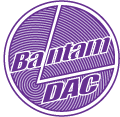
The TooleAudio BantamDAC
Overview
What is the BantamDAC?
| The TooleAudio BantamDAC is a USB-input, PCM2702 stereo high-fidelity Digital Audio Convertor. Software programming is not required. The BantamDAC, when properly assembled, will be automatically detected and installed upon plug-in to a Windows computer. Once installed, the BantamDAC will operate as a superior quality, off-board, stereo sound card for your Windows PC. It shows up in the Windows system as "USB Speakers" and can play *.wav, *.mp3, *.flac and other sound files through media players such as Windows Media Player, WinAMP, Foobar, and others. Output is through standard analog connections such as RCA, stereo 3.5mm/1/8" jacks or other stereo-compatible connectors. The Bantam represents one of the smallest layouts yet offered to the DIY community for Texas Instruments' PCM2702 DAC chip. The two-sided board is approximately 1" wide by 2" long. Yet, the full spectrum of USB-powered recommended components are included. The use of TPS regulators ensures better availability over the troubled supply of REG chips and require only a small SMD ceramic on the regulator's output. This means the board uses fewer electrolytic capacitors than something like the Alien DAC, a fore-runner of the Bantam. In addition, there is an option to use the Bantam as a "CableDAC, bypassing the USB connector and using a pig-tailed USB cable soldered directly to the board. This configuration provides an amazing combination of convenience and quality listening. The Bantam can be built for $25-$30, depending on case and connector selections, making it outstandingly economical as well. |
 (prototype pic)
|
|
 (prototype pic) | ||
 (prototype pic) |
||
What's needed ...
Basic construction and parts selection is covered in detail within these web pages. Other than the parts in the Bill of Materials, you will need a soldering iron and solder, sufficient for SMD PCB work. This is not as intimidating as it sounds - just be sure you have a low-power soldering iron with a small chisel tip and good solder (eutectic recommended) that is thin and easy to use. A Hakko 936 with a T-0.8D tip or equivalent will go a long way in success of building the Bantam, but is not strictly necessary. Solder should be on the order of 0.025" diameter or smaller, although smaller diameters can be difficult to use (lots of breakage). Eutectic solder is best - a blend of 63/37 tin/lead with a rosin flux core (non-corrosive).
Besides the miscellaneous tools used in PCB work such as needle-nose pliers (smooth jaws), flush cutters, DMM, and wiring tools - strippers, wire cutters, heat shrink, etc., there are a couple of specialized tools that can make the difference between success and failure with building SMD projects:Tweezers - These should not be from your mother's, wife's, or girlfriend's makeup kit. Instead, if you invest in only one tool for this project, a quality pair of SMD tweezers is it. There are many to select from and can be found at Mouser, DigiKey, Allied, Newark, and even Fry's. Try to buy one that's specific for SMD and not from a combination kit, unless the kit is specific for SMD work (in which case, it's probably way too expensive for this project). I purchased some #7 stainless-steel, non-magnetic curved tip tweezers:  These were somewhere around $10 for an off-brand copy (GoldTool at Fry's) and have worked fine for me, but be careful that you get good-quality ones with tips that do not flex and are as sharp as a pin, almost. Xcelite makes good ones (shown) and Wiha makes outstanding versions. Others go for the straight tweezers, but I find the curved tip is more natural for me. It is the only tweezer I use. Flux Pen - These are unbelievably helpful with SMD work, and also unbelievably sticky - so be careful. Used liberally, the flux from a flux pen can almost glue the part down. It can get a bit troublesome if you get it on the tip of your tweezers, though. Helping Hands - These are more or less obvious. I use ones that are only $1.99 at Harbor Freight, but you shouldn't have to spend more than about $5 almost anywhere that carries them. The board is way too small to hold with your hands while soldering. (Use some electrical tape to protect the PCB surface from the alligator clips.) How to get help ...
DIYforums.org has more than enough information to help you complete the BantamDAC. Besides these web pages, the forum itself provides ample opportunity
to search for answers or for asking direct questions. Most of the BantamDAC designers and prototypers are all very active forum participants and will do their best to get your problem solved.
In addition, there are many other builders that post and answer questions at:
Head-Fi and Headwize.
We hope you enjoy building and listening to the TooleAudio BantamDAC!
| ||
